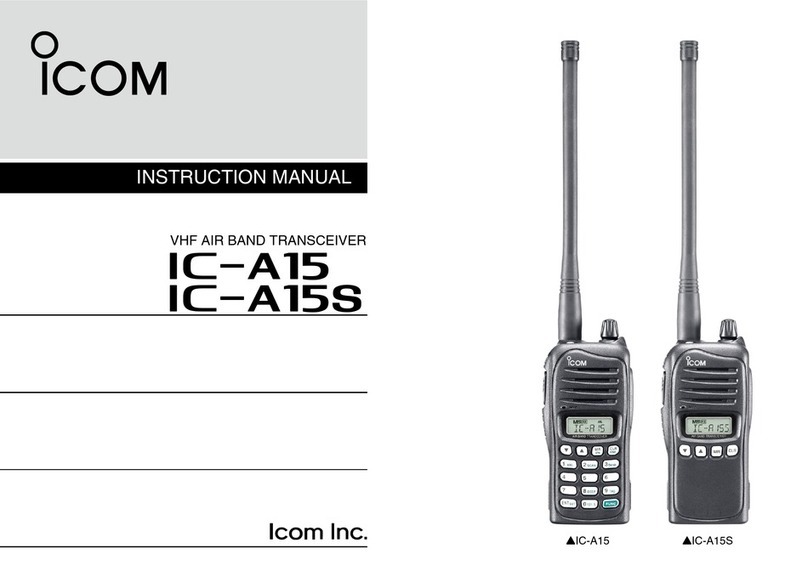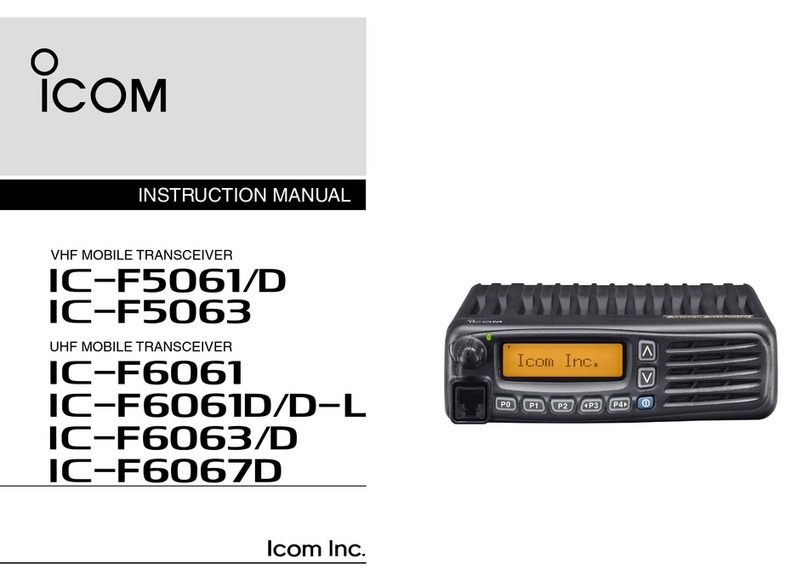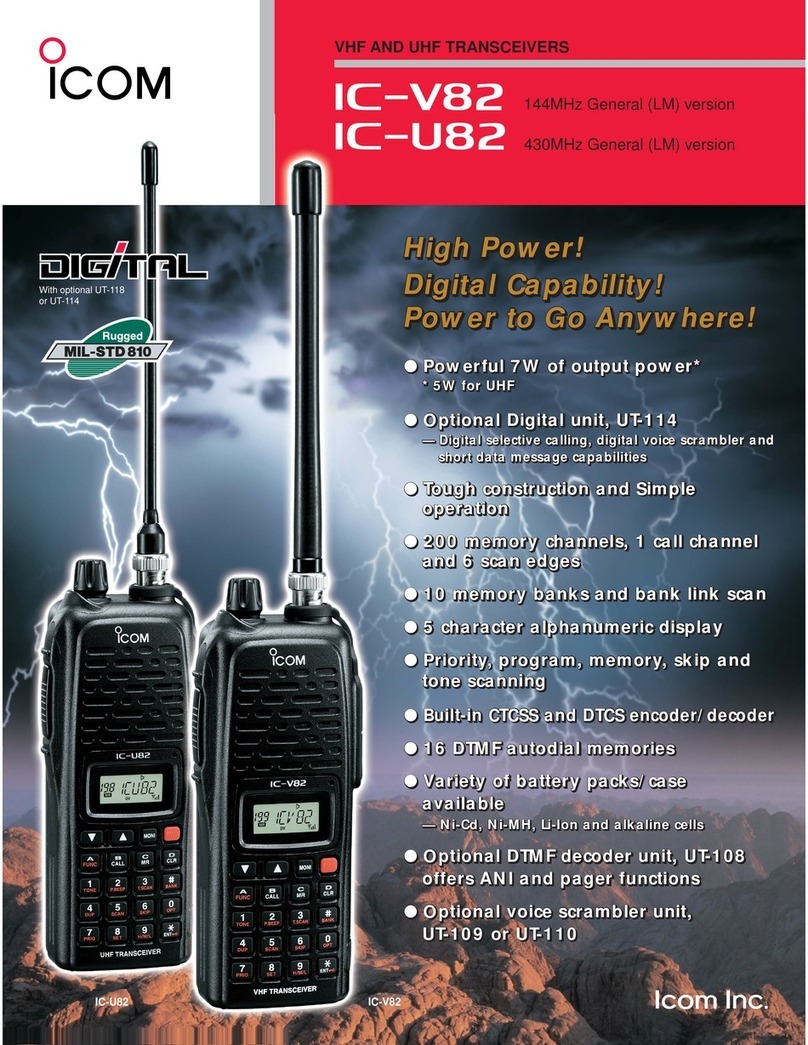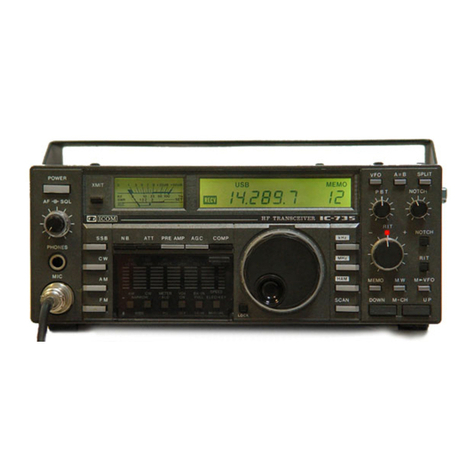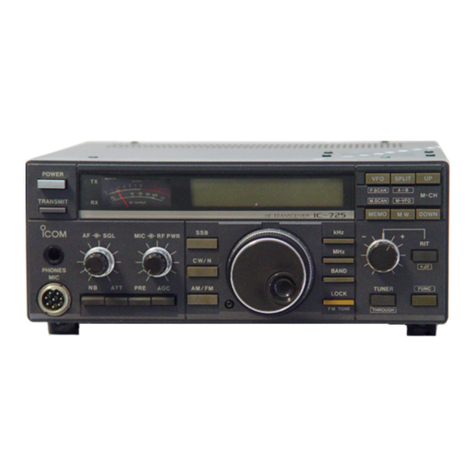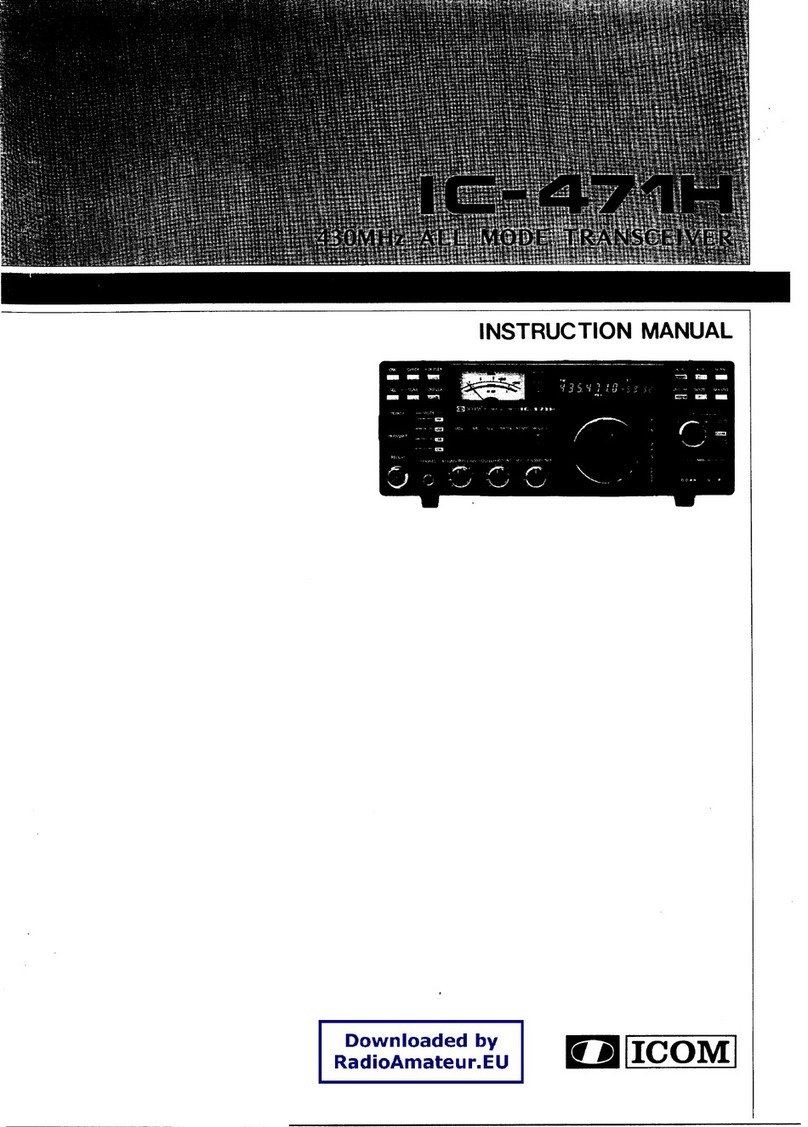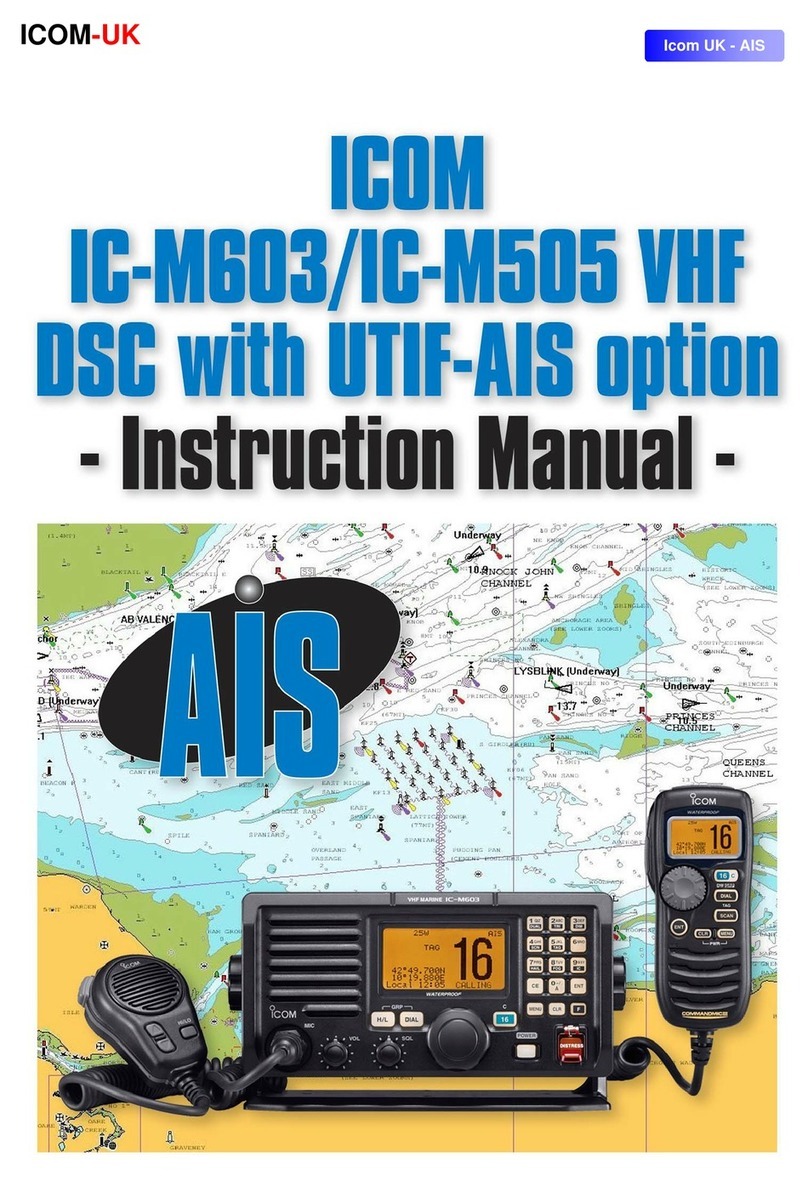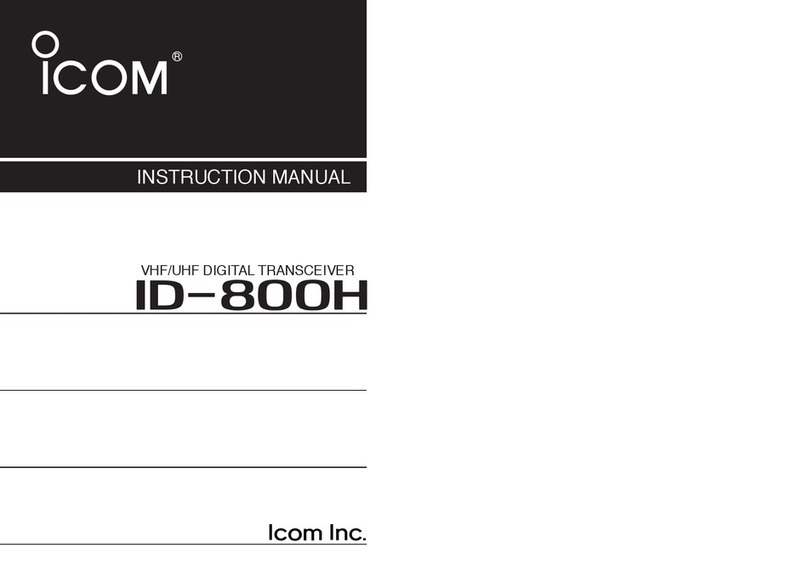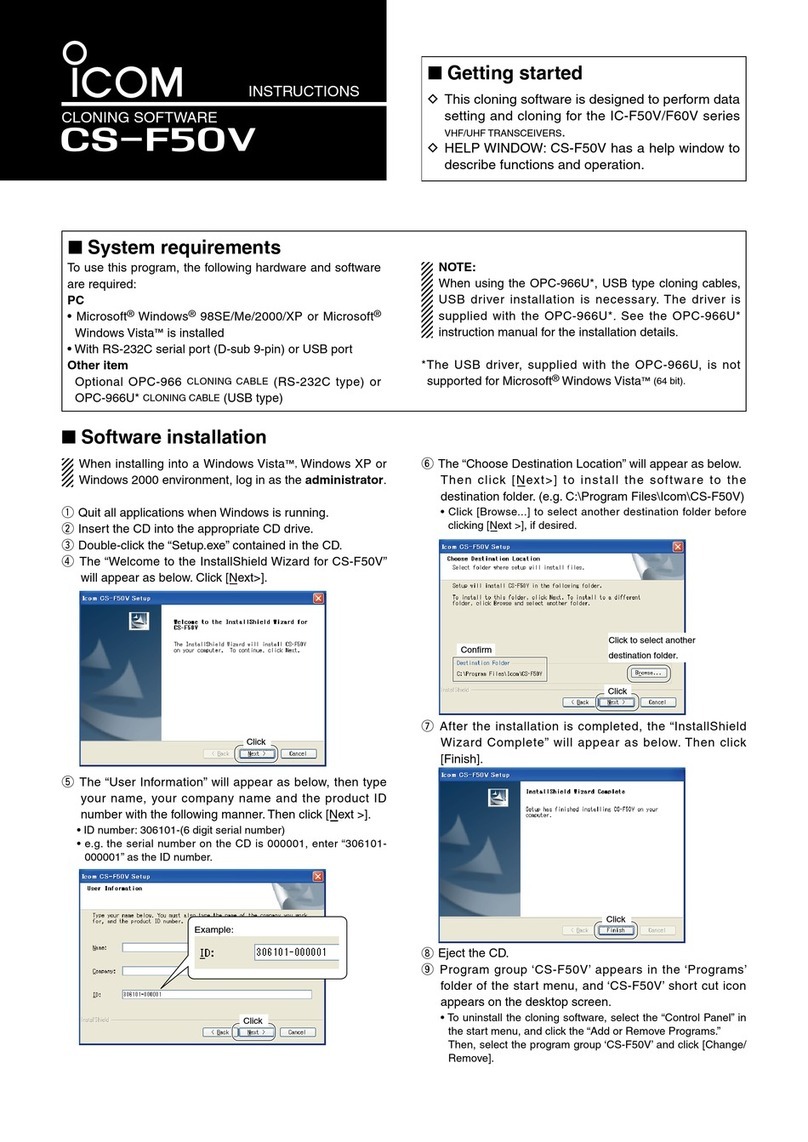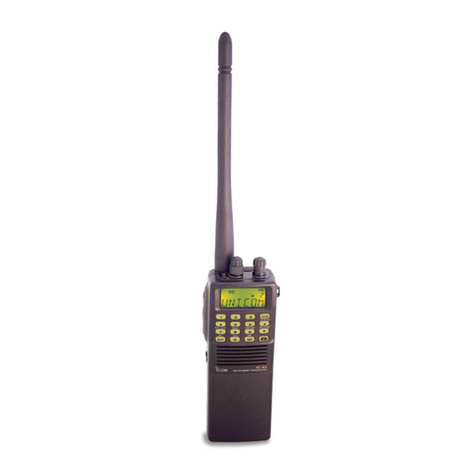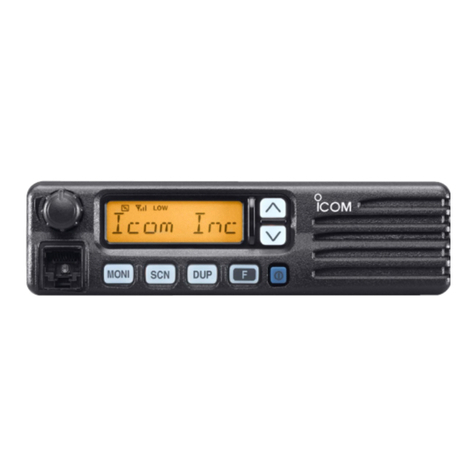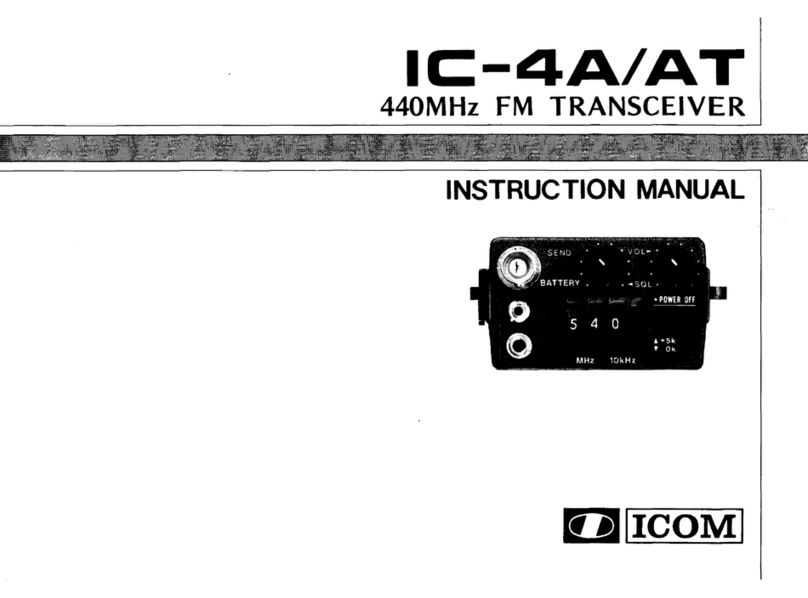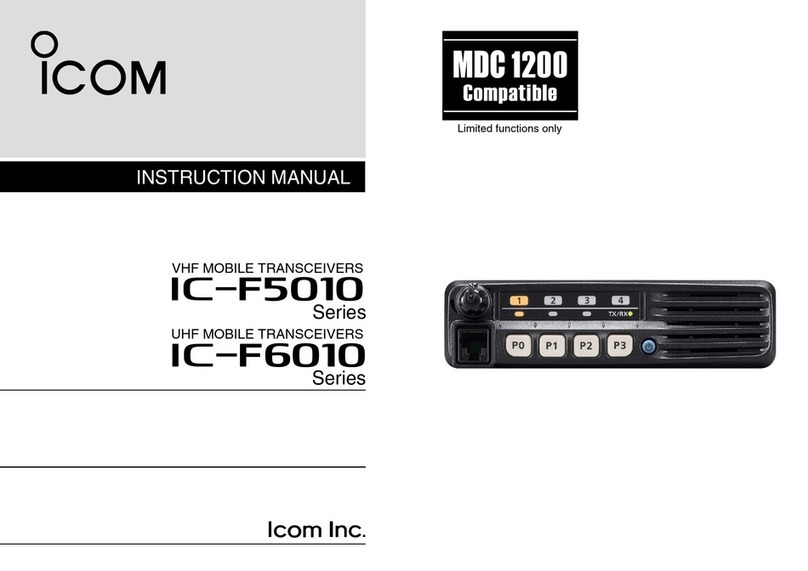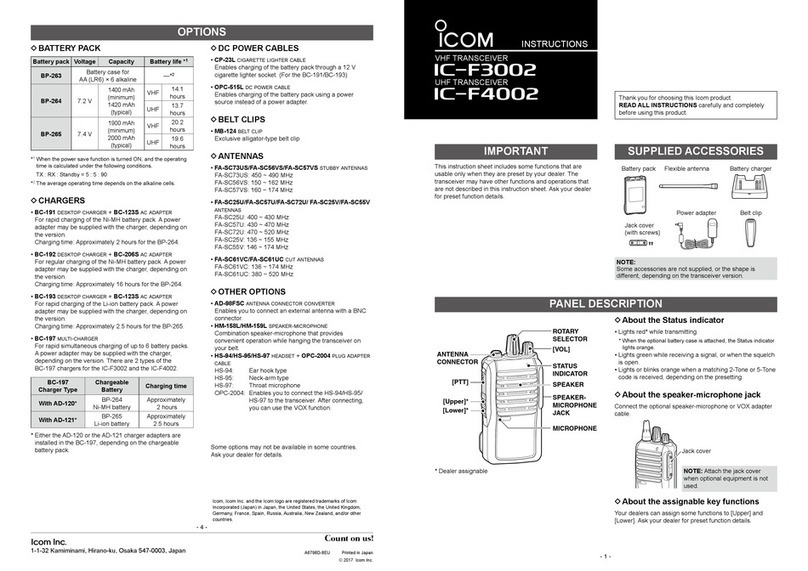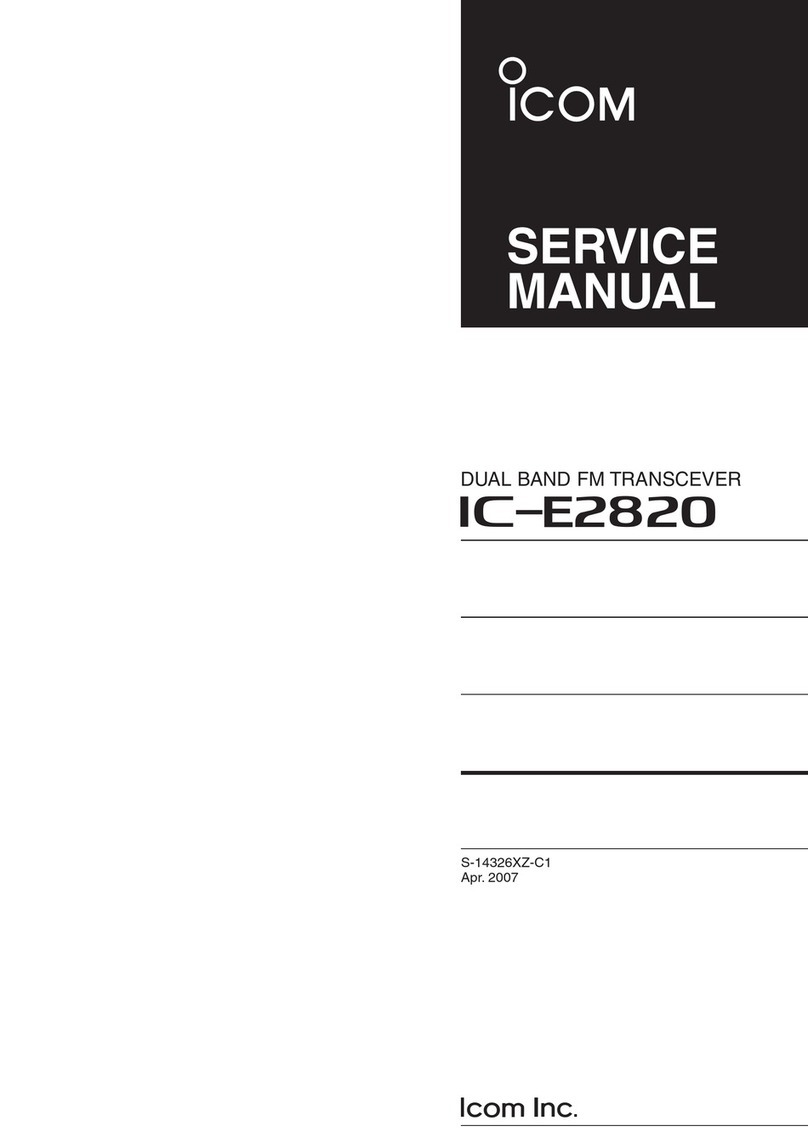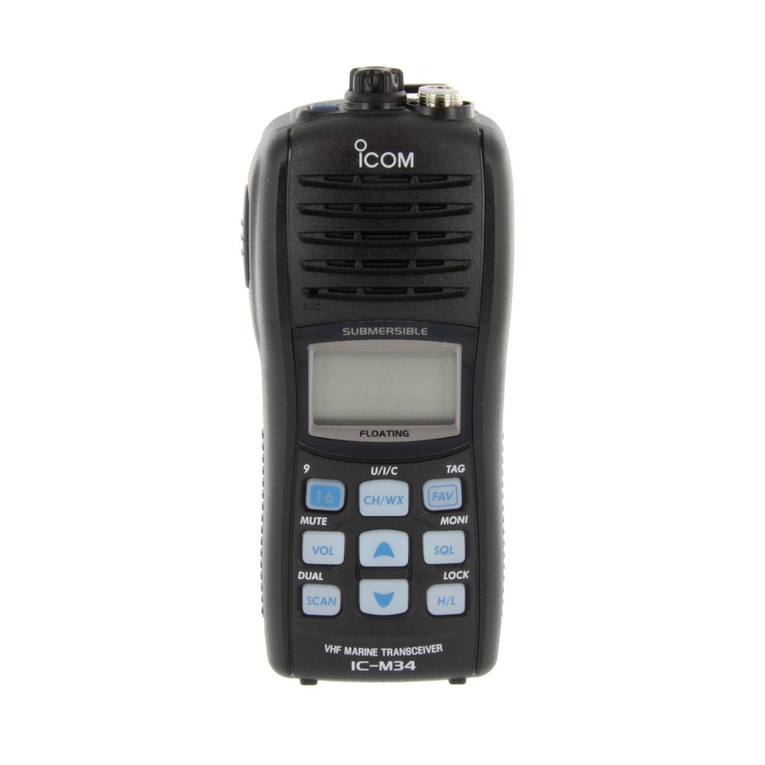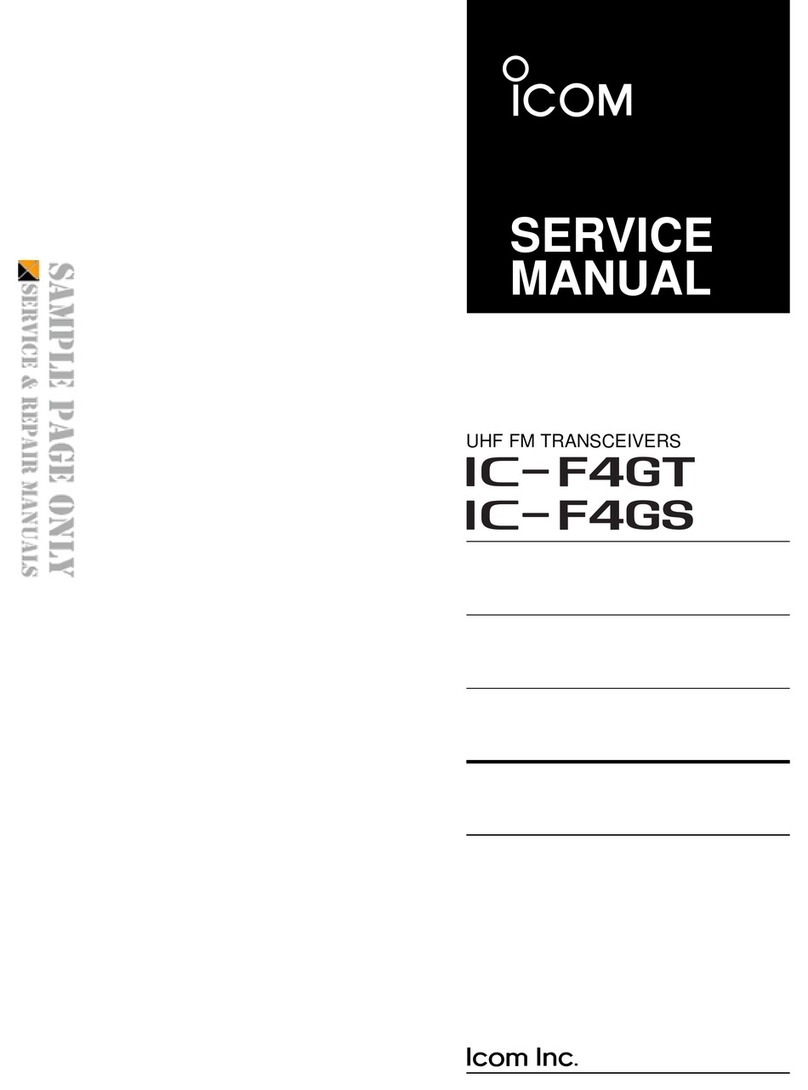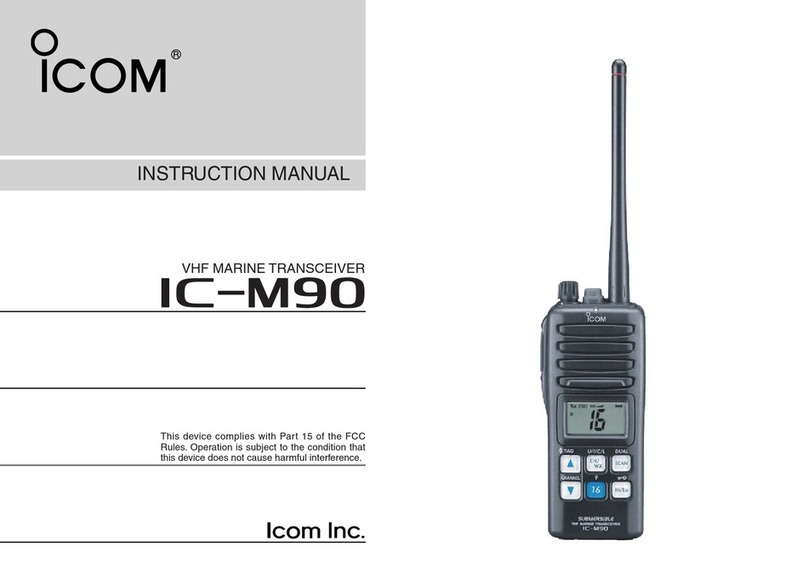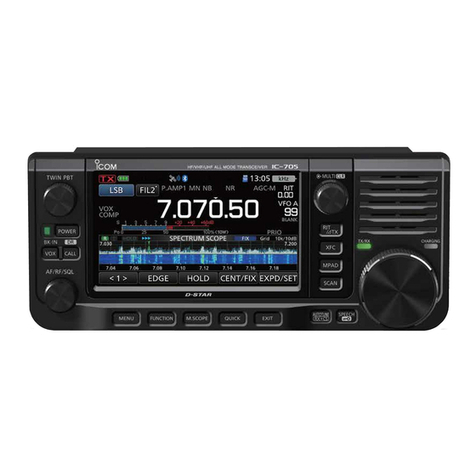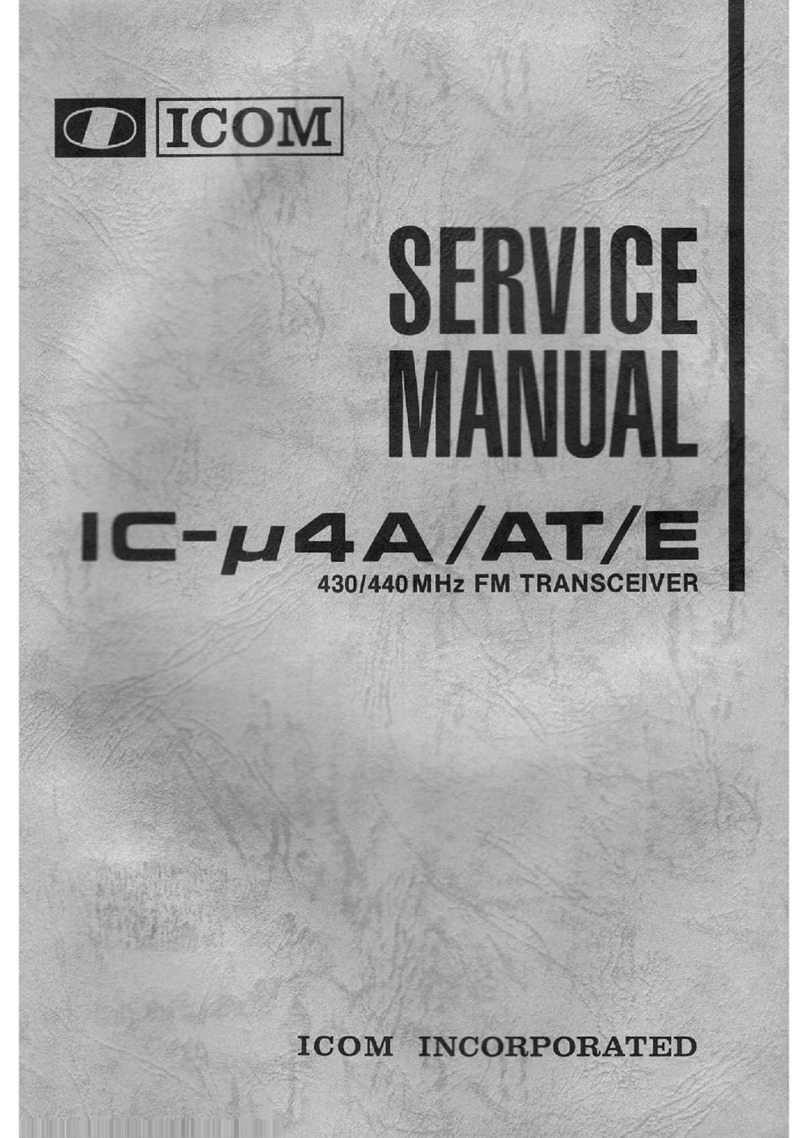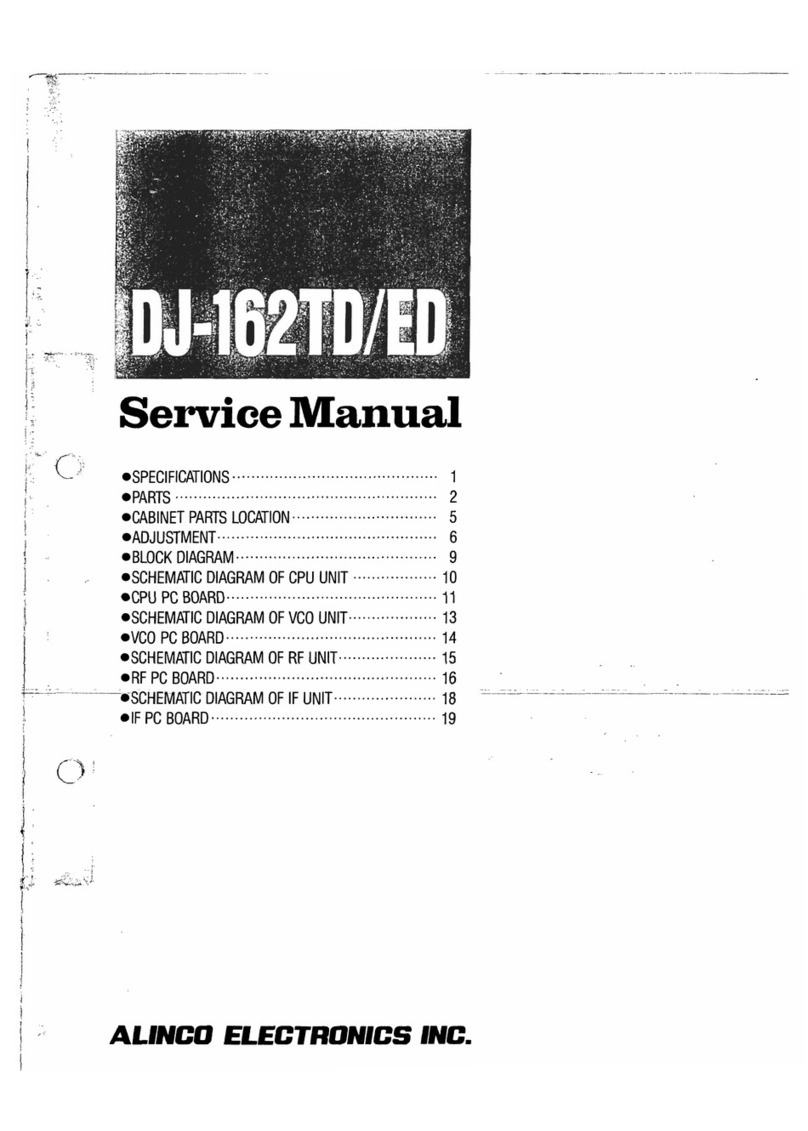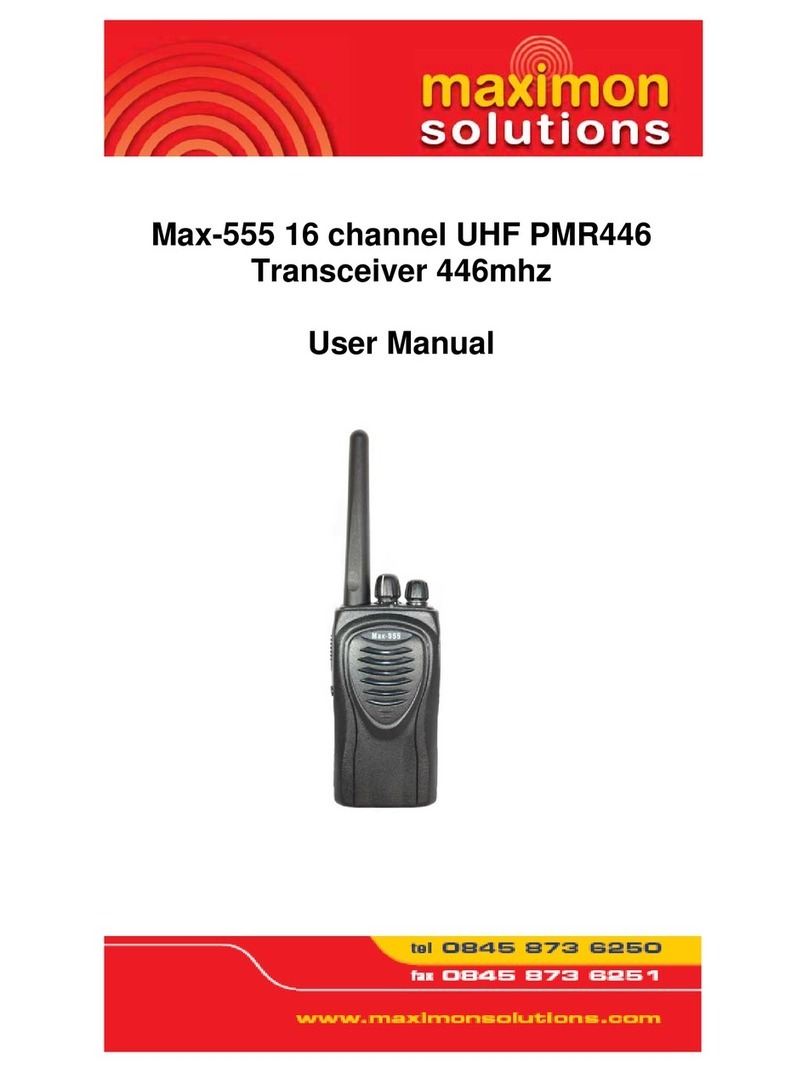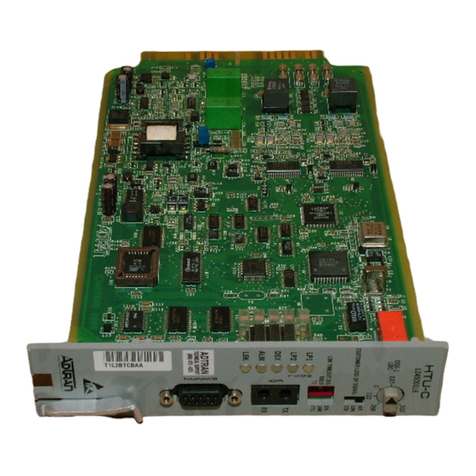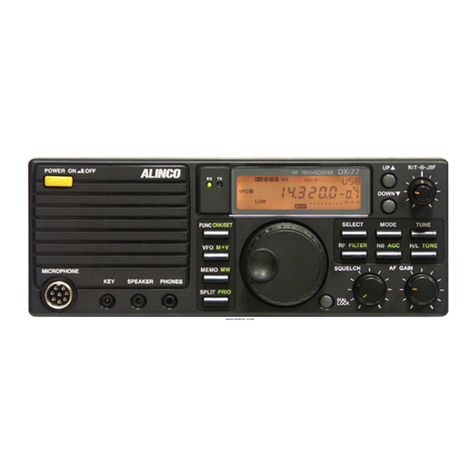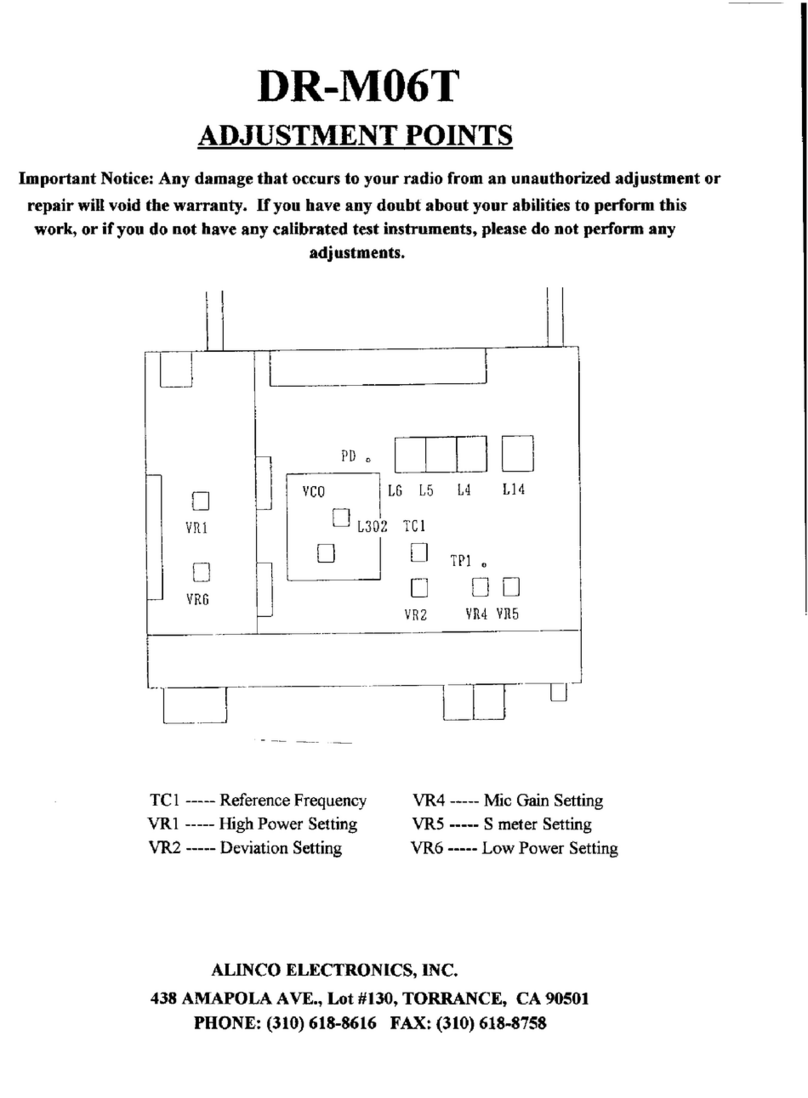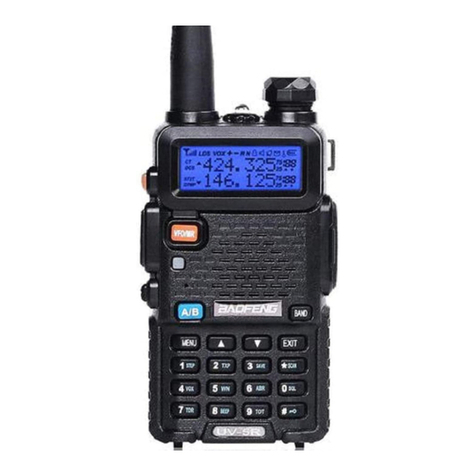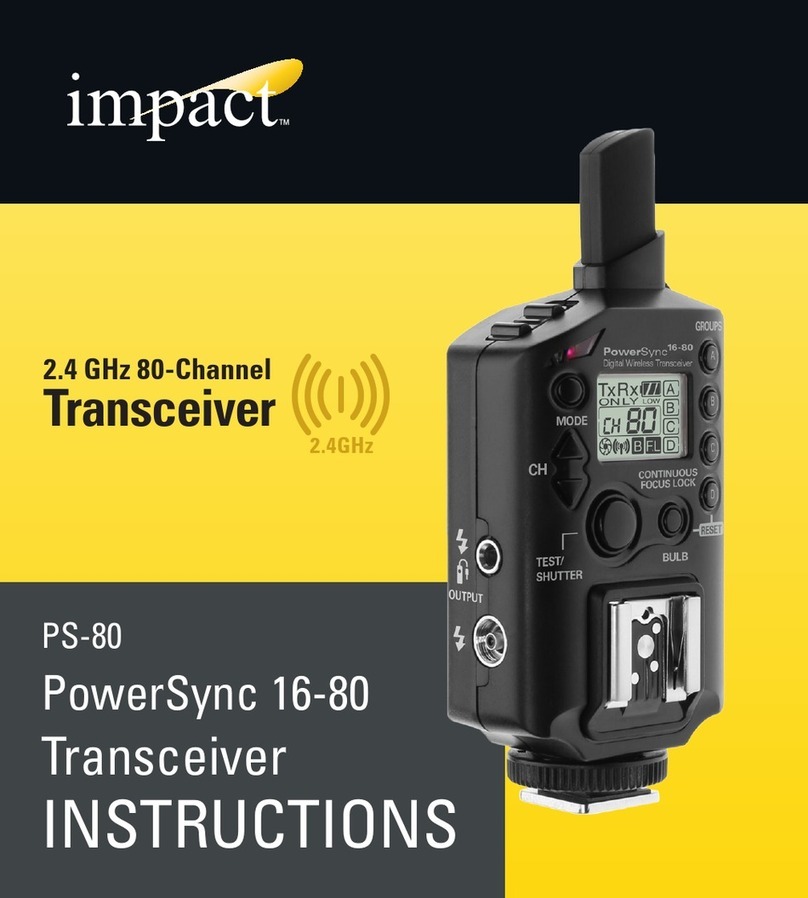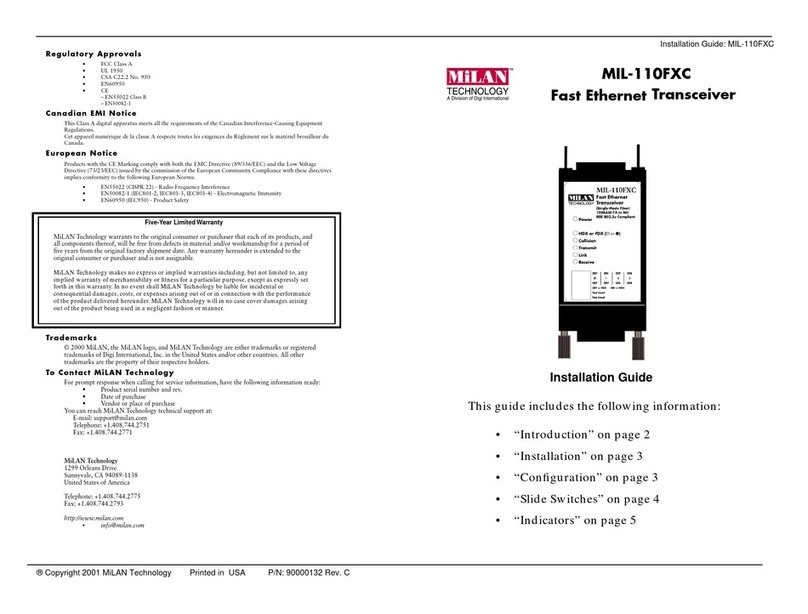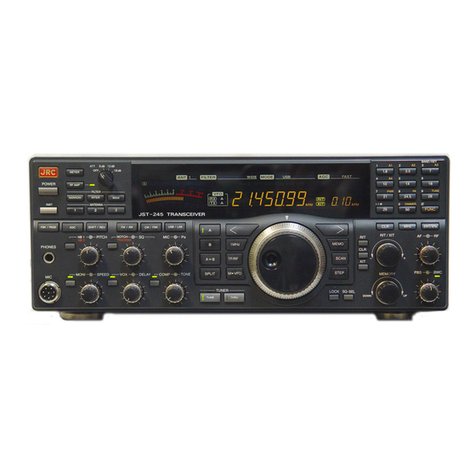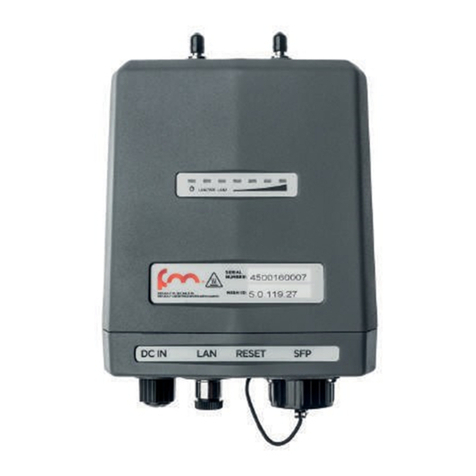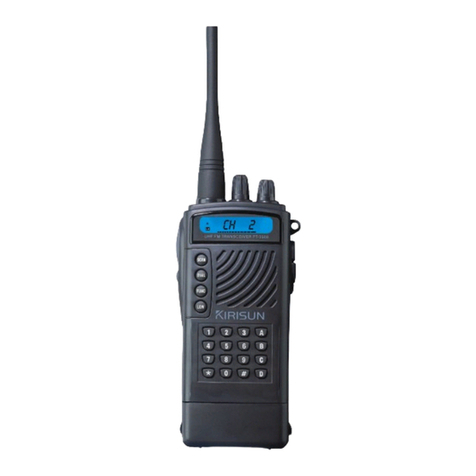Icom IC-A210 User manual

INSTALLATION GUIDE
VHF AIR BAND TRANSCEIVER
iA210 Thank you for choosing the IC-A210/IC-A210E vhf
air band transceiver
with Icom’s state of the art
technology.
Please read this installation guide and the
transceiver’s instruction manual carefully before
installing and operating.
The following accessories are supplied with the
IC-A210/IC-A210E. Inspect the quantity of each part
carefully.
qMounting bracket ………………………………………… 1
wCard edge connector (CR7E-30DB-3.96E) …………… 1
eScrews Bind UNC (No. 4 ×12.7) ……………………… 2
rBNC-LP ………………………………………………… 1
tWasher (Icom washer V) ……………………………… 1
yC-shaped ring …………………………………………… 1
uAntenna cable clip ……………………………………… 1
iSelf crimping nut (No. 6) ……………………………… 1
oNut (No. 6) ……………………………………………… 1
Make sure you have received all accessories and that there
is no shipping damage.
!0 Screw (No. 6 ×12.7) …………………………………… 1
!1 Crimp nuts (No. 6) ……………………………………… 6
!2 Screws (No. 6 ×12.7) …………………………………… 6
!3 COMM1 sticker ………………………………………… 1
!4 COMM2 sticker ………………………………………… 1
!5 Polarizing key …………………………………………… 1
!6 Speed nut UNC (No. 6) ………………………………… 4
!7 MB-113* ………………………………………………… 1
!8 Voltage sticker (IC-A210E only)………………………… 1
* Not supplied with some transceiver versions.
zIC-A210/IC-A210E SUPPLIED ACCESSORIES
qwer ty
uio!0 !1 !2 !3 !4 !5
!6 !7 !8
Select a location that can support the weight of the transceiver.
NEVER place the transceiver where normal navigation of the
aircraft may be hindered, or where it could cause bodily injury.
NEVER bend the cables sharply or place the cables too near
the aircraft control cables.
DO NOT place the transceiver where hot or cold air blows di-
rectly on it.
AVOID placing the transceiver in areas with temperatures
below –20˚C or above +55˚C (–4˚F to +131˚F).
NEVER connect the transceiver to a power source using re-
verse polarity. Reverse polarity will damage the transceiver.
To prevent voltage drops, solder or crimp the cable lug when
connecting the DC power cable to the power supply.
NEVER install an antenna near any aircraft projection, en-
gine or propeller.
Use a 50 Ω, vertically-polarized, VHF air band antenna.
VSWR should be less than 2.5:1.
Mount the antenna on a flat metal surface or install a ground
plane of at least 120 cm2(18 in2).
vPRECAUTIONS
When installing the IC-A210/IC-A210E in your aircraft, with
another connection system using a D-sub 15-pin connector,
use the supplied MB-113 as described below.
DAttachment
qUnscrew the 10 bottom screws, then remove the bottom
cover from the transceiver.
wUnscrew the 5 rear plate screws.
eDisconnect the I/O cable connectors and coaxial, J3, J4
and J6, then remove the rear plate from the transceiver.
IC-A210/IC-A210E
Plate
J6
J4
J3
rConnect the I/O cable connectors and coaxial onto the
MB-113 as illustrated below.
IC-A210/IC-A210E
MB-113
tAttach the MB-113 to the transceiver with the 5 rear plate
screws.
yReplace the removed bottom cover and 10 screws.
DPower cable wiring
Use 2 pairs of #18 AWG wires for power and power ground-
ing connections.
AF MPRS
1611 13 14 15
For the Card edge connector (Front view)
For the D-sub 15-pin (Front view)
18
915
Jumpers
Circuit
breaker
(10 A)
+
13.8 V DC
or 27.5 V DC
Circuit
breaker
(10 A)
+
13.8 V DC
or 27.5 V DC
Power ground
_
Power ground
_
• Circuit breaker
To prevent electrical damage, a 10 A circuit breaker MUST
be installed in the DC power line in the aircraft. Install the
circuit breaker in the aircraft breaker panel or instrument
panel to ensure easy access during flight.
• Ground
Connect the transceiver power ground to the airframe
ground.
• Jumpers
Pins 11, M, P and 13 MUST be jumped together with AWG
#20 wires or thicker.
DYoke-mounted channel and frequency exchange
switches
NOTE: Channel and frequency selections are available with
the Card edge connector only.
For the yoke-mounted channel switch and frequency ex-
change switch, use a 2-position spring loaded rocker switch
or 2 separate momentary push switches.
AS
1
L
12 15
OR
AS
1
L
12 15
DTransmit/receive interlock connections
When 2 transceivers are installed, connect pin N to
the other transceiver's pin 9 to prevent simultaneous
transmission of both transceivers.
However, when 2 transceivers are installed through a dual
audio panel, the connections are not necessary.
DAudio line connections
Use #24 AWG wires for connections.
AECD PR S
154
H
78 91015
For the Card edge connector (Front view)
For the D-sub 15-pin (Front view)
AECD PR S
154
HJ
78 915
14678
914151312
14678
91314
4 ΩSpeaker
4 Ω
Speaker
Headphone jack 1
(to 500 ΩHeadphones)
Headphone jack 1
(to 500 ΩHeadphones)
To auxiliary audio 1
To auxiliary audio 2
To auxiliary audio 3 Audio control panel
Headphone jack 2
Microphone
Jack 1
Microphone
Jack 2
To the PTT switch
To the Intercom switch
Headphone jack 2
4 ΩSpeaker
Headphone jack
(to 500 ΩHeadphones)
To auxiliary audio 1
To auxiliary audio 2
To auxiliary audio 3 Audio control panel
Microphone
Jack
To the PTT switch
To the PTT switch
To the Intercom switch
4 Ω
Speaker
Headphone jack
(to 500 ΩHeadphones)
To the PTT switch
Microphone
Jack
• Tw o places with intercom
• One place
• One place
• Tw o places with intercom
KJ
3
Microphone
Jack 1
Microphone
Jack 2
nCABLE CONNECTIONS
DCard edge connector
DD-sub 15-pin
mCONNECTOR INFORMATION
Pin I/O Description Pin I/O Description
A – No connection 1 Out RS-232 Serial data +(TXD)
B – No connection 2 In RS-232 Serial data +(RXD)
C In Auxiliary audio 2 +3 In Auxiliary audio 3 +
D In Auxiliary audio 1 +4 In Auxiliary audio 1, 2, 3 _
E Out External speaker +(4 Ω/5 W) 5 In External speaker _
F In Aircraft power _6 In Aircraft power _
H Out
Headphones audio +(500 Ω/60 mW)
7 Out Headphones audio _
J In Microphone 1+(600 Ω) 8 In Mic, Intercom, and PTT _
K In Microphone 2+(600 Ω) 9 In PTT +*
L In Memory channel switch* 10 In Intercom switch*
M In +13.8 V power +11 In +13.8 V power +
N – Transmit/receive interlock 12 In Frequency exchange switch*
P – No connection 13 – No connection
R In Aircraft power +(13.8/27.5 V) 14 In Aircraft power +(13.8/27.5 V)
S In Aircraft power _15 In Aircraft power _
*Ground to activate.
Pin I/O Description Pin I/O Description
1 In Aircraft power +(13.8/27.5 V) 9 In Aircraft power _
2 – No connection (reserved) 10 In RS-232 Serial data +(RXD)
3 Out RS-232 Serial data +(TXD) 11 I/O RS-232 Serial data _
4 In PTT +* 12 In Intercom select switch*
5 In Auxiliary audio +13 Out
External speaker and headphones _
6 Out External speaker +(4 Ω/5 W) 14 Out
Headphones audio
+
(500 Ω/60 mW)
7 In Microphone _15 In Microphone 2 +(600 Ω)
8 In Microphone 1 +(600 Ω)
*Ground to activate.
ABCDEFHJKLMNPRS
12345678910 11 12 13 14 15
Supplied polarizing key
Front view
Front view
12345678
9101112131415
*Ground to activate.
Pin
1
2
3
4
5
Pin
6
7
8
9
10
Pin
11
12
13
14
15
Aircraft power +(13.8/27.5 V)
No connection (reserved)
RS-232 Serial data +(TXD)
PTT +*
Auxiliary audio +
External speaker +(4 Ω/5 W)
Microphone _
Microphone 1 +(600 Ω)
Aircraft power _
RS-232 Serial data +(RXD)
RS-232 Serial data _
Intercom select switch*
External speaker and headphones _
Headphones audio +(500
Ω
/60 mW)
Microphone 2 +(600 Ω)
I/O
In
–
Out
In
In
I/O
Out
In
In
In
In
I/O
I/O
In
Out
Out
In
Description Description Description
About MB-113 :
Not supplied with some transceiver's versions.
iA210E
Either an intercom or a yoke-mounted channel/frequency
exchange switch can be installed. Both switches cannot be
installed at the same time.
The following items are required for installation but are NOT
supplied with the IC-A210/IC-A210E.
qVHF air band antenna for the communication band.
wVarious cables.
eAntenna cable with BNC connector (50 Ω).
rSwitches to be mounted on the aircraft yoke.
tHeadphones (500 Ω).
yLow-impedance carbon or dynamic microphone.
uPreamplifier for a dynamic microphone.
D
COMM1 and COMM2 stickers
When 2 transceivers are installed, to distinguish them from one
another, attach the supplied COMM1 and COMM2 stickers.
COMM
COMM1 or COMM2 sticker
xIMPORTANT
cINSTALLATION PROCEDURES
qCheck the quantity of parts. Refer to zIC-A210/IC-
A210E SUPPLIED ACCESSORIES.
wPrepare miscellaneous items required for installation.
Refer to Miscellaneous items in zIC-A210/IC-A210E
SUPPLIED ACCESSORIES.
ePrepare the required wiring. Refer to nCABLE
CONNECTIONS, mCONNECTOR INFORMATION and
,CARD EDGE CONNECTOR ASSEMBLY.
rAssemble the supplied mounting bracket and other parts.
Refer to ⁄1 MOUNTING BRACKET ASSEMBLY.
tCut the mounting hole. Refer to ⁄2 MARKING MOUNT-
ING HOLES.
yMount the IC-A210/IC-A210E into the mounting bracket.
Refer to ⁄3 MOUNTING TO THE BRACKET.
uCheck the IC-A210/IC-A210E operation. Refer to
.OPERATION CHECK.
bUSING THE MB-113
READ THIS, INSTALLATION GUIDE CAREFULLY
before attempting to install the IC- A210/IC-A210E in
an aircraft. This sheet contains important safety instructions.
NEVER install the transceiver where normal navigation of
the aircraft may be hindered.
NEVER install an antenna near any aircraft projection, en-
gine, or propeller.
INSTALL a circuit breaker between the aircraft battery and
the IC-A210/IC-A210E.
Check operation after installation.
Install the IC-A210/IC-A210E according to the procedures to
the right.
The antenna should also be spaced at least 1m (3.3 feet)
from any position occupied by any person on board of the
aircraft.

A-6602H-2EX-u
Printed in Japan
© 2007–2016 Icom Inc.
1-1-32 Kamiminami, Hirano-ku, Osaka 547-0003, Japan
Printed on recycled paper with soy ink.
The IC-A210/IC-A210E mates with a Card edge connector
in the rack mount. Assemble the Card edge connector as
follows.
DCard edge connector assembly
qStrip 4 mm (0.16″) from each wire for the card edge
connector.
wTin the leads of the wires.
ePass the wires through a short length of 13 mm (0.5″)
heat shrink tubing.
rSolder the leads to the contact terminals.
tCover the soldered terminals with the heat shrink tubing,
and heat until it is fixed in place.
yCover the unused terminals with the 10 mm (0.4″) heat
shrink tubing, then heat it to prevent shorting.
DPolarizing key
Before installing the Connector into the mounting bracket,
check the polarizing key position between contacts 8 and
9. Refer to Connector front view in m CONNECTOR IN-
FORMATION.
,CARD EDGE CONNECTOR ASSEMBLY
Check the following points after transceiver installation.
- Polarity of the power supply.
- NO interference caused to other equipment.
- NO noise or interference from other equipment.
- VSWR is less than 2.5:1.
- Communication capability on both the highest and lowest
communication frequencies, if possible.
.OPERATION CHECK
Connect the GPS receiver’s input/output terminals as described in the table.
⁄0 INFORMATION FOR GPS RECEIVER CONNECTION
GPS receiver’s terminal Connector D-sub connector
Input terminal pin 1 pin 3
Output terminal pin 2 pin 10
L-type BNC
connector
(user supplied)
Coaxial
connector
r BNC-LP
rBNC-LP
o Nut
u Antenna cable clip
i Self-crimping nut
t Washer
y C-shaped ring
!2 Screws
!0 Screw
e Screws Bind UNC
!5 Polarizing key
q Mounting
bracket
w Card edge connector
!1 Crimp nuts
q Mounting
bracket
When using the MB-53
!8 Voltage sticker
(IC-A210E only)
MB-53
⁄1 MOUNTING BRACKET ASSEMBLY
DNotes for making the mounting hole
The IC-A210/IC-A210E can be mounted securely in the
supplied mounting bracket.
Remember to allow adequate space for installation of cables
and connectors.
When installing 2 or more transceivers in a stack, the mount-
ing trays should be 1.3 mm (0.05″)apart.
The mounting bracket has 0.6 mm (0.024″)dimples in the
top, bottom, and both sides for proper spacing.
Mark and cut the mounting holes.
To support the mounting bracket, the rear mounting bosses
should be attached to the airframe.
⁄2 MARKING MOUNTING HOLES
DMounting bracket dimensions
160 mm; 6
5
⁄
16
″
33 mm; 1
5
⁄
16
″
260 mm; 10
1
⁄
4
″
DFront panel dimensions
160 mm; 6
5
⁄
16
″
34 mm; 1
11⁄32
″
MEMODUAL GRP
RCL
MEM
OFF
VOL
PUSH
TEST
COMM
DUAL
EC
iA210
Allow space for the front panel as shown above (illustration: IC-A210).
DTemplate
Cut out dimensions for the mounting bracket as follows.
160 mm; 6
5
⁄
16
″
33 mm; 1
5
⁄
16
″
DTransceiver installation
qRemove the front panel from the main unit, using a 3⁄32″
allen wrench, then carefully disconnect the flat cable from
the front panel. (Fig. 1)
wInsert a 3⁄32″ allen wrench into the hole of the main unit
and unscrew the inside lock screw until the inside metal
catch touches the chassis hole. (Fig. 2)
• Use the metal catch located on bottom side of the transceiver
when installing into the existing mounting bracket with the
MB-113 .
Use when installing with
the original mounting bracket.
Main unit front view
Using this hole when
installing with the MB-113.
eRotate the lock screw clockwise 4 revolutions (Fig. 3), and
then rotate counterclockwise a quarter revolution. (Fig. 4)
rInsert the main unit (transceiver) into the mounting
bracket. (Fig. 5)
tScrew the lock screw to fix the main unit (transceiver) to
the bracket. (Fig. 6)
yConnect the flat cable. (Fig. 7)
uAttach the front panel and re-screw the allen bolts (Fig. 7).
DTransceiver removal
The IC-A210/IC-A210E is easily removed from the mounting
bracket, if required.
qRemove the front panel from the main unit, using a 3⁄32″
allen wrench, then disconnect the flat cable from the front
panel.
wInsert a 3⁄32″ allen wrench into the hole of the main unit
and unscrew the inside lock screw.
eSlowly pull the transceiver out from the mounting bracket.
rConnect the flat cable to the front panel.
tAttach the front panel and tighten the allen screws.
Fig. 1
Fig. 6Fig. 5
Fig. 7
Fig. 1
Fig. 6Fig. 5
Fig. 7
Clockwise: For installation.
Counterclockwise: For removal.
CAUTION:
Treat the flat cable with care
when disconnecting it.
CAUTION:
Tr eat the flat cable with care
when connecting it.
Clockwise: For installation.
Counterclockwise: For removal.
Surface
Flat cable
Fig. 2 Fig. 4Fig. 3
Screw 4 revolutions Unscrew a quarter
revolution
• Metal catch position
Good! Bad
Metal catch
Surface
The flat cable
Fig. 2 Fig. 4Fig. 3
Screw 4 revolutions Unscrew a quarter
revolution
• Metal catch position
Metal catch
Flat cable
Good! Bad
Flat cable
⁄3 MOUNTING TO THE BRACKET
CAUTION: Treat the flat cable with care when
disconnecting it to avoid possible damage.
Improper care disconnecting the cable can cause
damage and result in severe non-warranty repair.
CAUTION: Make sure that the flat cable between the
transceiver and front panel is securely connected. The
transceiver may not function properly when loose or
when a wrong connection is made.
Improper care installing the cable can cause damage
and result in severe non-warranty repair.
Icom, Icom Inc. and the Icom logo are registered trademarks of Icom Incorporated (Japan) in the United States, the United Kingdom, Germany, France, Spain,
Russia, Australia, New Zealand, and/or other countries.
About e-marking: Detailed installation notes for Icom mobile transceivers to be fitted into vehicles are available. Please contact your Icom dealer or distributor.
Other manuals for IC-A210
9
This manual suits for next models
1
Table of contents
Other Icom Transceiver manuals
